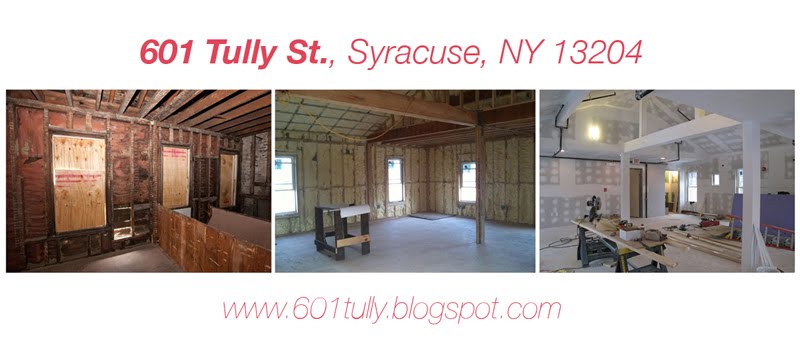About 601 Tully
Check out our new website! 601Tully.syr.edu
601 Tully is a center for engaged practice in Syracuse, NY developed by artist and professor Marion Wilson with a rotating collaborative team of 54 students and neighbors and Anda French of French 2Design. It's a site for meaningful exchange between artists, community members, and scholars in the co-production of culture.
601 Tully includes a contemporary art space, a public events space, a bookstore, a teaching garden, and Recess Cafe West.
In 2009, Wilson purchased the condemned two-story home and local drug hub, and throughout five semesters, Wilson's design/build class re-zoned, designed, renovated and now sustains the physical and programmatic aspects of 601 Tully. The collaborative team has consisted of artists, architects, environmentalists, Fowler High School students, Green Train Workforce, neighbors, and the occasional passerby.
601 Tully is made possible by the generous support of the Syracuse University School of Education, The Kauffman Foundation, The Near West Side Initiative, Imagining America, Home HeadQuarters Inc., Say Yes to Education, and National Grid.
Find us on Facebook!
Tuesday, December 14, 2010
Difference and Privilege
The issue of difference is critical to any understanding of identity formation, collective or otherwise, and the limitations of community-based art. 601 Tully seeks to understand these differences to better serve the community of the Near West Side, a politically coherent geographic area whose formation and development were actively controlled by politics. As a piece of 'new genre public art' 601 interacts with the audience, or community, about issues directly relevant to their lives. That is why the exact role of the place is left a little undefined, for the community to fill in the blanks later when it can understand its needs for the place better. Kwon argues that art in the public interest can and should affect social/political change. 601 Tully encourages community coalition building in pursuit of social justice while at the same time acting as the agent, a privilege granted to them by higher institutional powers. I got involved with this project as a way for me to get involved in the Syracuse community as a whole. I wanted to understand the new place I was living, and what better way than on a project that actively engages a part of it, and strives to understand the difference (and privileges) between "them" and "us". Success of community based art can be measured in the extent that the self expression of the community affirms the notion of a coherent collective subject and I hope that 601 will continue to be successful and affect the change needed by the community of the Near West Side.
I've learned from my participation in the class that the sum is always greater than the whole. Our class and the larger 601 Tully family partaking in the project are individuals making up the artistic whole. The same thing goes for the Near West Side community; it is made up of individuals each bringing something special and different to the whole. My work with 601 focuses on these individuals, rather than the whole entity, by crafting benches with care and by helping each person have a voice on the wall of drawings, all exclaiming their uniqueness. In my own work, both as an architect and an artist, I always want to be involved in the community, not to be removed from the people my work is for. Architecture is ultimately a service industry and as such I want to always be able to understand the privileges and differences between the industry, myself, and the individuals/whole of the audience.

No comments:
Post a Comment